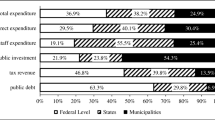Abstract
Fiscal illusion refers to a systematically biased perception of fiscal parameters, due to demand-side error/ignorance or supply-side abusive behaviour. As such it is a component of a more general tax choice framework.
This paper focuses predominantly on the empirical estimation of the four major sources of fiscal illusion, namely the flypaper effect, renter illusion and the complexity and elasticity of tax systems. The results — based on a dataset of 302 Flemish municipalities — on balance suggest the existence of important illusionary effects.
Similar content being viewed by others
References
Baker, S.H. (1983). The determinants of median voter tax liability: An empirical test of the fiscal illusion hypothesis.Public Finance Quarterly 11: 95–108.
Barr, J.L. and Davis, O.A. (1966). An elementary political and economic theory of the expenditures of local government.Southern Economic Journal 33: 149–165.
Bergstrom, T.C. and Goodman, R.P. (1973). Private demands for public goods.American Economic Review 63: 280–296.
Borcherding, T.E. and Deacon, R.T. (1972). The demand for the services of non-federal governments.American Economic Review 62: 891–901.
Breeden, Ch.H. and Hunter, W.J. (1985). Tax revenue and tax structure.Public Finance Quarterly 13: 216–224.
Buchanan, J.M. (1960).Fiscal theory and political economy. Chapel Hill: University of North Carolina Press.
Buchanan, J.M. (1967).Public finance in democratic process. Chapel Hill: University of North Carolina Press.
Clotfelter, C.T. (1976). Public spending for higher education: An empirical test of two hypotheses.Public Finance 31: 177–195.
Courant, P.G. and Rubinfeld, D. (1979). The stimulative effects of intergovernmental grants: Or why money sticks where it hits. In P. Mieszkowksi and W. Oakland (Eds.),Fiscal federalism and grants-in-aid, 5–21. Washington, DC: The Urban Institute.
Craig, E.D. and Heins, A.J. (1980). The effect of tax elasticity on government spending.Public Choice 35: 267–275.
DiLorenzo, T.J. (1982). Tax elasticity and the growth of local public expenditure.Public Finance Quarterly 10: 385–392.
Dougan, W.R. and Kenyon, D.A. (1988). Pressure groups and public expenditures: The flypaper effect reconsidered.Economic Inquiry 26: 159–170.
Feenberg, D.R. and Rosen, H.S. (1987). Tax structure and public sector growth.Journal of Public Economics 32: 185–201.
Filimon, R., Romer, T. and Rosenthal, H. (1982). Asymmetric information and agenda control.Journal of Public Economics 17: 51–70.
Fisher, R.C. (1982). Income and grant effects on local expenditure: The flypaper effect and other difficulties.Journal of Urban Economics 12: 324–345.
Hamilton, B.W. (1983). The flypaper effect and other anomalies.Journal of Public Economics 22: 347–361.
Heyndels, B. (1989). Fiskale perceptie bij de gemeenteraadsverkiezingen.De Gemeente 64 (no 4), 159–163.
Hirschman, A.O. (1964). The paternity of an index.American Economic Review 54: 761–762.
Logan, R.R. (1986). Fiscal illusion and the grantor government.Journal of Political Economy 94: 1304–1318.
Martinez-Vazquez, J. (1983). Renters' illusion or savvy?Public Finance Quarterly 11: 237–243.
Megdal, S.B. (1987). The flypaper effect revisited: An econometric explanation.Review of Economics & Statistics 69: 347–351.
Munley, V.G. and Green, K.V. (1978). Fiscal illusion, the nature of public goods and equation specification.Public Choice 33: 95–100.
Oates, W.E. (1975). Automatic increases in tax revenues: The effect on the size of the public budget. In W. Oates (Ed.),Financing the new federalism: Revenue sharing, conditional grants, and taxation. Baltimore: John Hopkins Press, 139–160.
Oates, W.E. (1979). Lump-sum intergovernmental grants have price effects. In P. Mieszkowski and W.H. Oakland (Eds.),Fiscal Federalism and Grants-in-Aid. Washington: The Urban Institute, 23–30.
Oates, W.E. (1988). On the nature and measurement of fiscal illusion: A survey. In G. Brennanet al. (Eds.),Taxation and fiscal federalism: Essays in honour of Russel Mathews. Sydney: Australian National University Press, 65–82.
Oates, W.E. (1990). Public finance with several levels of government: Theories and reflections. International Institute of Public Finance, 46th Congress, Brussels.
O'Brien, J.P. and Shieh, Y.N. (1990). Utility functions and fiscal illusion from grants.National Tax Journal 18: 201–205.
Peterson, G.E. (1975). Voter demand for public school expenditures. In J. Jackson (Ed.),Public needs and private behavior in metropolitan areas, 99–120. Cambridge, MA: Ballinger.
Pommerehne, W.W. and Schneider F. (1978). Fiscal illusion, political institutions and local spending.Kyklos 31: 381–408.
Puviani, A. (1903). Teoria della illusione finanziaria. Milan: Remo Sandon.
Romer, T. and Rosenthal, H. (1979). Bureaucrats vs. voters: On the political economy of resource allocation by direct democracy.Quarterly Journal of Economics 93: 562–587.
Rose, R. and Karran, T. (1987).Taxation by political inertia. London: Allen & Unwin.
Schokkaert, E. (1987). Preferences and demand for local public spending.Journal of Public Economics 34: 175–188.
Turnbull, G.K. (1992). Fiscal illusion, uncertainty, and the flypaper effect.Journal of Public Economics 48: 207–223.
Wagner, R.E. (1971).The fiscal organization of American federalism. Chicago: Markham.
Wagner, R.E. (1976). Revenue structure, fiscal illusion and budgetary choice.Public Choice 25: 45–61.
Winer, S.L. (1983). Some evidence on the effect of the separation of spending and taxing decisions.Journal of Political Economy 91: 126–140.
Wyckoff, P.G. (1988). A bureaucratic theory of flypaper effects.Journal of Urban Economics 28: 115–129.
Wyckoff, P.G. (1991). The elusive flypaper effect.Journal of Urban Economics 30: 310–328.
Author information
Authors and Affiliations
Additional information
We thank Prof. Dr. R.S. Gassler, Prof. Dr. M. Jegers, Prof. Dr. J. Vuchelen and an anonymous referee for helpful comments.
Rights and permissions
About this article
Cite this article
Heyndels, B., Smolders, C. Fiscal illusion at the local level: Empirical evidence for the Flemish municipalities. Public Choice 80, 325–338 (1994). https://doi.org/10.1007/BF01053224
Accepted:
Issue Date:
DOI: https://doi.org/10.1007/BF01053224




